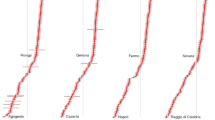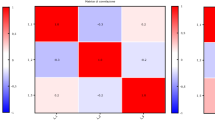Abstract
Equitable and sustainable well-being (in Italian, “BES”) has become an integral part of the decision-making process of economic and financial planning. By now, the needs of up-to-date and accurate measures of BES at local level is certain. Among BES indicators, several are obtained from Labour Force Survey (LFS) data. LFS provided estimates keeping with the highest quality and methodology standards required by the new Integrated European Social Statistics (IESS) framework regulation. The aim of this paper is to extend recent improvements in LFS variance estimation methodology also to BES indicators computed on LFS data. The direct consequence is that, besides estimates, accuracy measures can be provided. This can help researchers and decision makers to analyze the performance among the Italian regions and their evolution over time.


Source: our elaboration on Italian Labour force Survey data
Similar content being viewed by others
Notes
The description of the dimensions and a list of the 130 indicators is available in English at the link https://www.istat.it/en/well-being-and-sustainability/the-measurement-of-well-being/indicators (last access 9th August, 2020).
Population by gender and 14 5-years age groups at NUTS2 level; Population by gender and 5 age groups at NUTS3 level and for the 13 biggest municipalities; monthly population by gender at NUTS2 level; number of households by wave at NUTS2 level; foreigner population (Male, Female, EU and Not EU) at NUTS2 level.
See, e.g., Berger and Priam (2016) for the estimator for the correlation in rotating repeated surveys.
Because \({}_{q}\widehat{Y}\) is obtained with the calibrated estimator \(\widehat{\mathrm{var}}\left({}_{q}\widehat{Y}\right)\) is estimated with expression (3.4) in Deville and Särndal (1992, p. 380).
References
Berger, Y. G., & Priam, R. (2016). A simple variance estimator of change for rotating repeated surveys: An application to the European Union Statistics on income and living conditions household surveys. Journal of the Royal Statistical Society: Series A (Statistics in Society), 179(1), 251–272.
Binder, D. A. (1983). On the variances of asymptotically normal estimators from complex surveys. International Statistical Review, 51(3), 279–292.
Binder, D. A., & Patak, Z. (1994). Use of estimating functions for estimation from complex surveys. Journal of the American Statistical Association, 89(427), 1035–1043.
Bleys, B. (2012). Beyond GDP: Classifying alternative measures for progress. Social Indicators Research, 109(3), 355–376.
Cochran, W. G. (2007). Sampling techniques. New Jersey: John Wiley & Sons.
Ceccarelli, C., Chianella, D., De Filippo, F., Graziani, C., Guandalini, A., Lattanzio, M., et al. (2017). Quality improvements in variance estimation for the labour force survey. RivistaItaliana di EconomiaDemografia e Statistica, 71(4), 15–25.
Ciommi, M., Gigliarano, C., Emili, A., Taralli, S., & Chelli, F. M. (2017). A new class of composite indicators for measuring well-being at the local level: An application to the equitable and sustainable well-being (BES) of the Italian provinces. Ecological indicators, 76, 281–296.
DEF (2017). Ministry of Economy and Finance, Economic and Finance Document. Retrieved 2017 from https://www.mef.gov.it/en/focus/article_0031.html.
Deville, J. C., & Särndal, C.-E. (1992). Calibration estimators in survey sampling. Journal of the American Statistical Association, 87, 376–382.
EU-COR, European Union, Committee of the Regions (2012). Delivering on the Europe 2020 Strategy. Handbook for Local and Regional Authorities. C.O.R, Bruxelles, https://portal.cor.europa.eu/europe2020.
Hall, J., Giovannini, E., Morrone, A., & Ranuzzi, G. (2010). A framework to measure the progress of societies. France: OECD Publishing.
Horvitz, D. G., & Thompson, D. J. (1952). A generalization of sampling without replacement from a finite universe. Journal of the American statistical Association, 47(260), 663–685.
ISTAT (2006). La rilevazione sulle forze di lavoro: contenuti, metodologie, organizzazione. Metodi e norme n. 32.
ISTAT (2013). Bes 2013. Il benessere equo e sostenibile in Italia. Roma: Istat.
ISTAT. (2017). BES report 2017: Equitable and sustainable well-being in Italy. Roma: Istat.
ISTAT. (2020). BES report 2019: Equitable and sustainable well-being in Italy. Roma: Istat.
Massoli, P., Mazziotta, M., Pareto, A., Rinaldelli, C. (2014). Indici compositi per il BES. In: Giornate Delle Ricerca in Istat, Istat.
Mazziotta, M., & Pareto, A. (2013). Methods for constructing composite indices: One for all or all for one. RivistaItaliana di EconomiaDemografia e Statistica, 67(2), 67–80.
Mazziotta, M., & Pareto, A. (2016). On a generalized non-compensatory composite index for measuring socio-economic phenomena. Social Indicators Research, 127(3), 983–1003.
OECD. (2008). Handbook on constructing composite indicators. Methodology and user guide. Paris: OECD Publications.
OECD. (2011). How’s life? measuring well-being. Paris: OECD Publications.
OECD. (2014). How’s life in your region? measuring regional and local well-being for policy making. Paris: OECD Publications.
Särndal, C.-E. (2007). The calibration approach in survey theory and practice. Survey Methodology, 33(2), 99–119.
Särndal, C. E., & Lundström, S. (2005). Estimation in surveys with nonresponse. USA: John Wiley & Sons.
Stiglitz J. E., Sen A., Fitoussi J. P. (2009). Report by the Commission on the Measurement of Economic Performance and Social Progress. Retrieved 2009 from https://ec.europa.eu/eurostat/documents/118025/118123/Fitoussi+Commission+report.
Taralli, S., Capogrossi, C., & Perri, G. (2015). Measuring equitable and sustainable well-being (BES) for policy-making at local level (NUTS3). RivistaItaliana di EconomiaDemografia e Statistica, 69(3), 95–107.
Taralli, S., & D’Andrea, P. (2013). BES indicators at local level: Application to policy cycle and evaluation. Measuring progress at a local level book of abstracts (pp. 13–16). Pisa: University Press.
Vallée, A. A., & Tillé, Y. (2019). Linearisation for variance estimation by means of sampling indicators. Application to Non-response. International Statistical Review, 87(2), 347–367.
Wolter, K. (2007). Introduction to variance estimation. Berlin: Springer Science & Business Media.
Acknowledgements
The authors would like to thank the editor, the guest editors and three anonymous referees who kindly review this manuscript and provided valuable suggestions and comments for improving it.
Author information
Authors and Affiliations
Corresponding author
Additional information
Publisher's Note
Springer Nature remains neutral with regard to jurisdictional claims in published maps and institutional affiliations.
Rights and permissions
About this article
Cite this article
Ceccarelli, C., Guandalini, A., Martini, A. et al. Accuracy Evaluation of LFS-BES Indicators: A Regional Assessment. Soc Indic Res 161, 989–1002 (2022). https://doi.org/10.1007/s11205-020-02532-3
Accepted:
Published:
Issue Date:
DOI: https://doi.org/10.1007/s11205-020-02532-3




